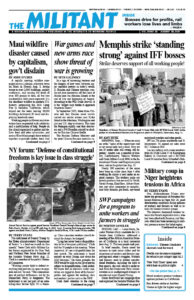In a sign of increasing tensions and the dangers of new wars between major capitalist powers in today’s world, 11 Russian and Chinese warships conducted joint maneuvers off the coast of Alaska near the Aleutian Islands at the end of July and beginning of August. According to the Wall Street Journal, it is the “largest such flotilla to approach American shores.”
In September 2022, when three Chinese and four Russian naval vessels carried out similar actions near Kiska Island in the Aleutians, Washington sent just one U.S. ship to observe. This time the Pentagon rapidly sent four destroyers and a P-8 Poseidon aircraft to shadow the Russian-Chinese flotilla.
The Russian Defense Ministry said the joint Chinese-Russian exercises included destruction of a mock enemy submarine as well as helicopter landing-and-takeoff practice on each other’s ships.
While a direct conflict between U.S. imperialism and its allies on one side and the regimes in Moscow and Beijing on the other is not yet imminent, disputes over their clashing economic, political and military interests are on the rise across the world.
Moscow’s Feb. 24, 2022, invasion of Ukraine — the largest land and air war on European soil in decades — accelerated shifts in alliances among imperialist powers and capitalist governments worldwide and set off a new arms race. As capitalist ruling classes compete for markets and profits, they are also preparing for wars to come.
Although weakened in many ways, U.S. imperialism remains the dominant economic and military power in the world, capitalism’s last empire. Meanwhile, the Chinese rulers have been challenging the U.S.’s reach, especially in the Asia-Pacific region.
This has been sharpest over the South China Sea. Beijing has been building militarized artificial islets and using its armed power to claim islands disputed with regional regimes, some U.S. allies, from Vietnam and the Philippines to Taiwan, Malaysia and Brunei.
U.S. and Chinese planes and ships are increasingly “shadowing” each other recently as each capitalist power asserts its “rights” in the South China Sea.
Beijing’s “Belt and Road Initiative” program of loans and construction projects to advance its reach and influence around the world is also to lay the groundwork for military alliances and bases.
Competition between Washington and Beijing is rising in Africa as well. In 2021 China’s two-way trade with Africa reached $254 billion, four times more than U.S. trade there. Beijing opened its first, and so far only, foreign military base, in Djibouti, East Africa in 2017. It’s just miles from a U.S. base, operating there since 2003.
While Beijing is expanding its naval and other military capacity, by most measures it is far behind U.S. armed might.
One example: Washington has 11 nuclear-powered aircraft carriers that can each accommodate 60 or more aircraft. Beijing has three, none of them nuclear powered. Moscow has one — and if it can pull together a crew, it might sail in 2024.
In 2020 U.S. military spending was estimated at $778 billion, nearly 39% of total global military spending. Beijing was a distant second, at $252 billion. But in the wake of Moscow’s invasion of Ukraine, capitalist powers around the world are taking steps to boost their military forces.
Big jump in ammunition production
The Pentagon is organizing to increase production of artillery shells by 500% within two years. The New York Times reported Jan. 24 that this is part of “pushing conventional ammunition production to levels not seen since the Korean War.”
In its 2022 National Defense Strategy review, the U.S. Department of Defense stated that strategic competition with the People’s Republic of China is “the most comprehensive and serious challenge to U.S. national security.” It complains about Beijing’s “increasingly aggressive endeavor to refashion the Indo-Pacific region and the international system to suit its interests and authoritarian preferences.”
The Chinese Defense Ministry issued a statement while the Russian and Chinese ships were in international waters off the Alaska coast. It said the joint operations were not “directed against third parties and have nothing to do with the current international and regional situation.”
But a few days later the English-language Global Times, which reflects of the views of the Chinese Communist Party, put a wider perspective more bluntly. “It is ironic that all US forces involved in shadowing the China-Russia joint flotilla” off the coast of Alaska, the paper said, have been involved previously in military operations in the Taiwan Straits or “trespassing into Chinese territorial waters in the South China Sea.”
“It exposes the US’s double standard that only allows its military presence near other countries, but doesn’t accept other countries’ military presence near it,” the paper said. “The Americans should get used to it.”

